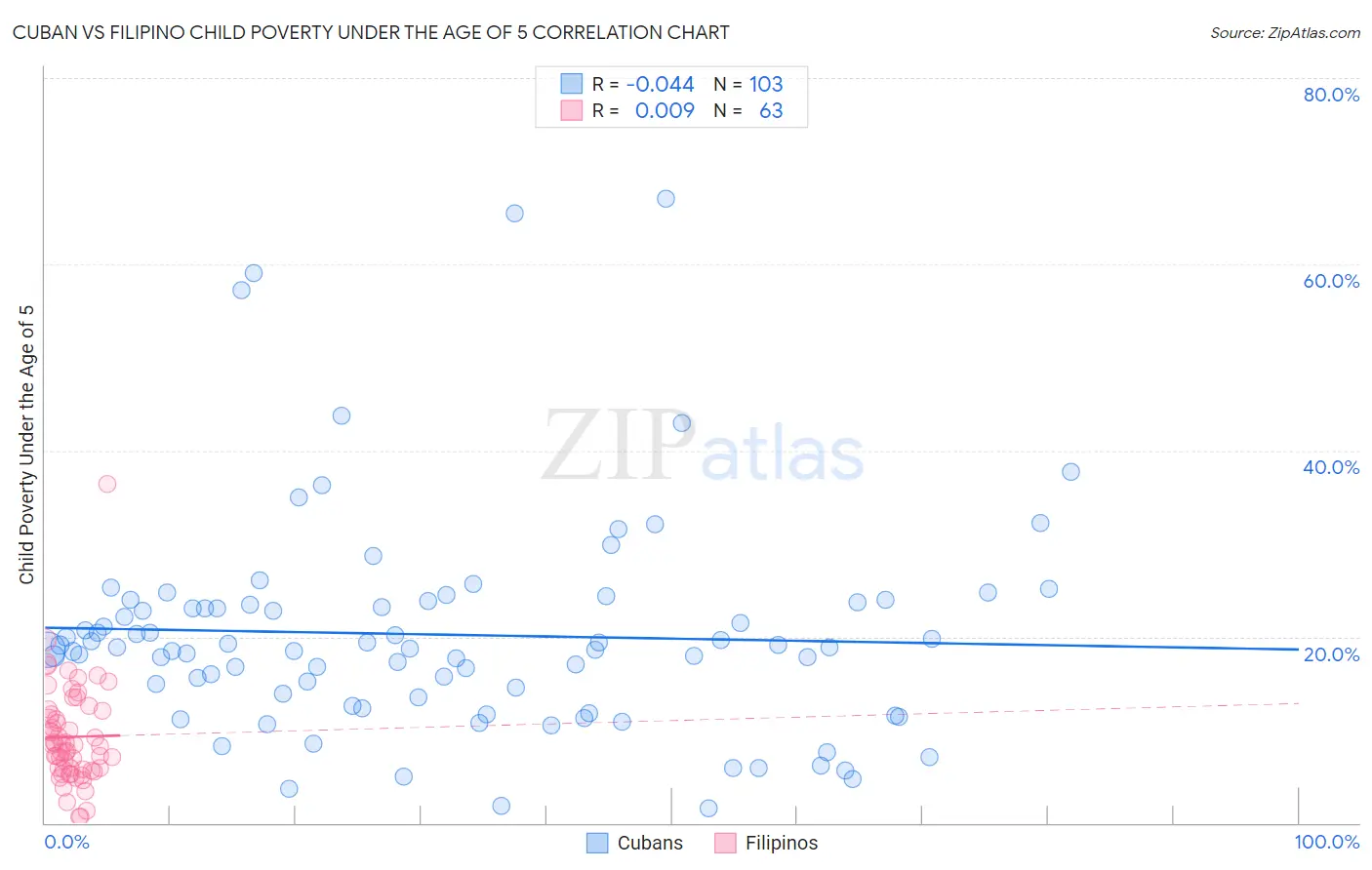Cuban vs Filipino Child Poverty Under the Age of 5
COMPARE
Cuban
Filipino
Child Poverty Under the Age of 5
Child Poverty Under the Age of 5 Comparison
Cubans
Filipinos
19.1%
CHILD POVERTY UNDER THE AGE OF 5
1.7/ 100
METRIC RATING
223rd/ 347
METRIC RANK
11.6%
CHILD POVERTY UNDER THE AGE OF 5
100.0/ 100
METRIC RATING
3rd/ 347
METRIC RANK
Cuban vs Filipino Child Poverty Under the Age of 5 Correlation Chart
The statistical analysis conducted on geographies consisting of 429,948,450 people shows no correlation between the proportion of Cubans and poverty level among children under the age of 5 in the United States with a correlation coefficient (R) of -0.044 and weighted average of 19.1%. Similarly, the statistical analysis conducted on geographies consisting of 245,031,118 people shows no correlation between the proportion of Filipinos and poverty level among children under the age of 5 in the United States with a correlation coefficient (R) of 0.009 and weighted average of 11.6%, a difference of 64.2%.

Child Poverty Under the Age of 5 Correlation Summary
| Measurement | Cuban | Filipino |
| Minimum | 1.6% | 0.63% |
| Maximum | 67.1% | 36.4% |
| Range | 65.5% | 35.7% |
| Mean | 20.2% | 9.2% |
| Median | 18.8% | 8.3% |
| Interquartile 25% (IQ1) | 13.5% | 5.7% |
| Interquartile 75% (IQ3) | 23.6% | 12.1% |
| Interquartile Range (IQR) | 10.1% | 6.4% |
| Standard Deviation (Sample) | 11.7% | 5.5% |
| Standard Deviation (Population) | 11.7% | 5.5% |
Similar Demographics by Child Poverty Under the Age of 5
Demographics Similar to Cubans by Child Poverty Under the Age of 5
In terms of child poverty under the age of 5, the demographic groups most similar to Cubans are Alsatian (19.1%, a difference of 0.020%), Nicaraguan (19.1%, a difference of 0.11%), Nigerian (19.1%, a difference of 0.14%), Immigrants from Eritrea (19.1%, a difference of 0.16%), and Cape Verdean (19.1%, a difference of 0.34%).
| Demographics | Rating | Rank | Child Poverty Under the Age of 5 |
| Hmong | 5.0 /100 | #216 | Tragic 18.5% |
| Immigrants | Africa | 4.6 /100 | #217 | Tragic 18.6% |
| Delaware | 3.4 /100 | #218 | Tragic 18.7% |
| German Russians | 3.0 /100 | #219 | Tragic 18.8% |
| Immigrants | Azores | 2.6 /100 | #220 | Tragic 18.9% |
| Immigrants | Nigeria | 2.1 /100 | #221 | Tragic 19.0% |
| Alsatians | 1.7 /100 | #222 | Tragic 19.1% |
| Cubans | 1.7 /100 | #223 | Tragic 19.1% |
| Nicaraguans | 1.6 /100 | #224 | Tragic 19.1% |
| Nigerians | 1.6 /100 | #225 | Tragic 19.1% |
| Immigrants | Eritrea | 1.5 /100 | #226 | Tragic 19.1% |
| Cape Verdeans | 1.4 /100 | #227 | Tragic 19.1% |
| Immigrants | Sudan | 1.3 /100 | #228 | Tragic 19.2% |
| Ghanaians | 1.2 /100 | #229 | Tragic 19.2% |
| Ecuadorians | 1.2 /100 | #230 | Tragic 19.2% |
Demographics Similar to Filipinos by Child Poverty Under the Age of 5
In terms of child poverty under the age of 5, the demographic groups most similar to Filipinos are Immigrants from Taiwan (11.6%, a difference of 0.24%), Immigrants from India (11.5%, a difference of 0.96%), Thai (12.3%, a difference of 6.0%), Immigrants from Hong Kong (12.4%, a difference of 7.1%), and Immigrants from Singapore (12.9%, a difference of 11.4%).
| Demographics | Rating | Rank | Child Poverty Under the Age of 5 |
| Immigrants | India | 100.0 /100 | #1 | Exceptional 11.5% |
| Immigrants | Taiwan | 100.0 /100 | #2 | Exceptional 11.6% |
| Filipinos | 100.0 /100 | #3 | Exceptional 11.6% |
| Thais | 100.0 /100 | #4 | Exceptional 12.3% |
| Immigrants | Hong Kong | 100.0 /100 | #5 | Exceptional 12.4% |
| Immigrants | Singapore | 100.0 /100 | #6 | Exceptional 12.9% |
| Chinese | 100.0 /100 | #7 | Exceptional 13.1% |
| Iranians | 100.0 /100 | #8 | Exceptional 13.1% |
| Immigrants | Iran | 100.0 /100 | #9 | Exceptional 13.1% |
| Burmese | 100.0 /100 | #10 | Exceptional 13.2% |
| Immigrants | Korea | 100.0 /100 | #11 | Exceptional 13.2% |
| Immigrants | South Central Asia | 100.0 /100 | #12 | Exceptional 13.3% |
| Bhutanese | 100.0 /100 | #13 | Exceptional 13.4% |
| Okinawans | 100.0 /100 | #14 | Exceptional 13.4% |
| Indians (Asian) | 100.0 /100 | #15 | Exceptional 13.4% |